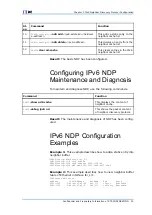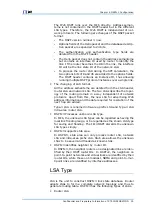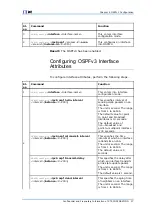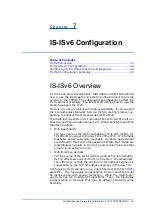
ZXR10 T600/T1200 User Manual (IPv6 Volume)
According to design, RIPv1 and RIPv2 to adapt to both
suite and other network protocol suites. Therefore, routing
table entries of a packet contain network protocol suite field.
However, it is seldom used for other non-IP networks in
practice. Therefore, support to this function is removed from
RIPng.
�
Next Hop
There is no information about next hop in RIPv1. The router at
the receiving end takes the source address of a packet as the
next hop for the route to the destination network. RIPv2 con-
tains explicit information about the next hop, thus facilitating
selection of the optimum route and avoiding routing loop and
slow convergence.
Different from RIPv1 and RIPv2, the next hop field in RIPng
exists as a separate RTE to avoid overlong Routing table Entry
(RTE) and to improve efficiency in route information transmis-
sion.
�
Packet Length
Both RIPv1 and RIPv2 set limit to the length of a packet, pro-
visioning that each packet can only carry at most 25 RTEs.
However, RIPng has no limit to the length of a packet and the
number of RTEs. The length of a packet depends on the Maxi-
mum Transmission Unit (
) of a medium. Processing on the
packet length by RIPng enables networks to improve efficiency
in route information transmission.
�
Security Consideration
RIPv1 packets contain no authentication information which re-
sults in insecurity. Any host that sends packets through the
UDP Port 520 will be regarded as a router by its neighbor host,
which is likely to cause router spoofing. RIPv2 is designed to
contain authentication packets to enhance security. Although
routers that exchange routes with each other cannot receive
route information from each other before authentication, RIPv2
does not have adequate security.
IPv6 contains perfect security policies, so there is no need to
design separate security authentication packet for RIPng any
more but to use IPv6 security policies.
�
Packet Transmission Mode
RIPv1 sends route information through broadcast. In this way,
both routers and all the hosts within the same
can receive
packets, which is unnecessary and insecure.
However, both RIPv2 and RIPng can send packets either
through broadcast or through multicast. In this way, packets
can be sent through multicast in networks that support mul-
ticast, thus greatly reducing the quantity of route information
that is transmitted in networks.
28
Confidential and Proprietary Information of ZTE CORPORATION
Содержание ZXR10 T1200
Страница 5: ...Figures 71 Tables 73 List of Glossary 75 ...
Страница 6: ......
















































